The Ultimate Salesforce Marketing Cloud Guide: A-Z Topics Covered for Beginners & Experts
1. Introduction
Salesforce Marketing Cloud is a powerful platform designed to help businesses manage and optimize their customer journeys. This guide will walk you through all the essential aspects of Salesforce Marketing Cloud, from setting up email campaigns to advanced segmentation and lead scoring.
2. Overview of Salesforce Marketing Cloud
Salesforce Marketing Cloud is a comprehensive platform that enhances marketing efforts through various digital channels. It provides companies with tools to streamline, personalize, and automate marketing interactions, making it possible to deliver the right message to the right audience at the optimal time.
2.1 Core Components
- Email Studio: For creating and managing email campaigns.
- Journey Builder: For designing customer journeys.
- Audience Builder: For creating and managing customer segments.
- Content Builder: For managing and organizing content.
- Analytics Builder: For tracking and analysing marketing performance.
Salesforce Marketing Cloud is a comprehensive platform designed to help businesses manage and optimize their customer journeys. It provides a suite of tools that enable marketers to create personalized, multi-channel campaigns and manage customer interactions seamlessly. Here’s a detailed look at each core component:
2.1.1 Email Studio: For Creating and Managing Email Campaigns
Email Studio is the cornerstone of Salesforce Marketing Cloud, enabling you to design, send, and track email campaigns. Here’s a deeper dive into its capabilities:
- Email Creation: Use drag-and-drop tools to create visually appealing email templates. You can also import existing HTML templates for more complex designs.
- Personalization: Leverage dynamic content to personalize emails based on customer data, such as name, location, and past interactions.
- A/B Testing: Run A/B tests to determine which email content performs best. This helps in optimizing open rates and click-through rates.
- Automation: Set up automated email workflows based on customer actions, such as welcome emails, abandoned cart reminders, and re-engagement campaigns.
- Compliance and Deliverability: Ensure your emails comply with regulations like GDPR and CAN-SPAM. Use tools to monitor and improve email deliverability.
2.1.2 Journey Builder: For Designing Customer Journeys
Journey Builder is a powerful tool for creating personalized customer journeys across multiple channels. Here’s how it works:
- Visual Workflow Designer: Use a drag-and-drop interface to map out customer journeys. Define entry criteria, decision splits, and exit conditions.
- Multi-Channel Orchestration: Design journeys that span email, SMS, push notifications, and social media. Ensure a cohesive experience across all touchpoints.
- Real-Time Engagement: Use real-time data to adjust journeys dynamically based on customer behaviour. This ensures that interactions are timely and relevant.
- Customer Data Integration: Pull data from Salesforce CRM and other sources to create highly personalized journeys.
- Performance Tracking: Monitor the performance of your journeys and make data-driven adjustments to improve outcomes.
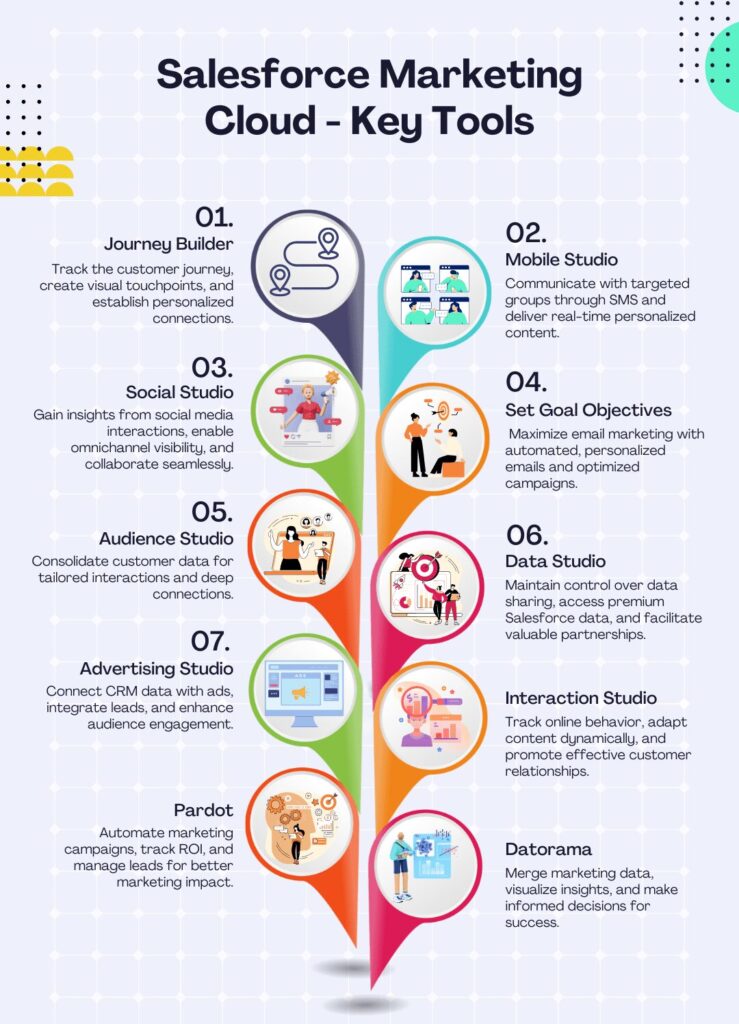
2.1.3 Audience Builder: For Creating and Managing Customer Segments
Audience Builder helps you create and manage customer segments based on various criteria. Here’s how it enhances your marketing efforts:
- Segmentation: Use Waterfall Segmentation to create detailed segments based on customer behavior, demographics, and other data points.
- Contact Builder: Manage your data extensions and relational data models to ensure accurate segmentation.
- Dynamic Segmentation: Create segments that update in real-time based on customer interactions.
- Integration with Salesforce CRM: Sync your segments with Salesforce CRM to ensure a unified view of your customers.
- Testing and Optimization: Continuously test and refine your segments to improve targeting and engagement.
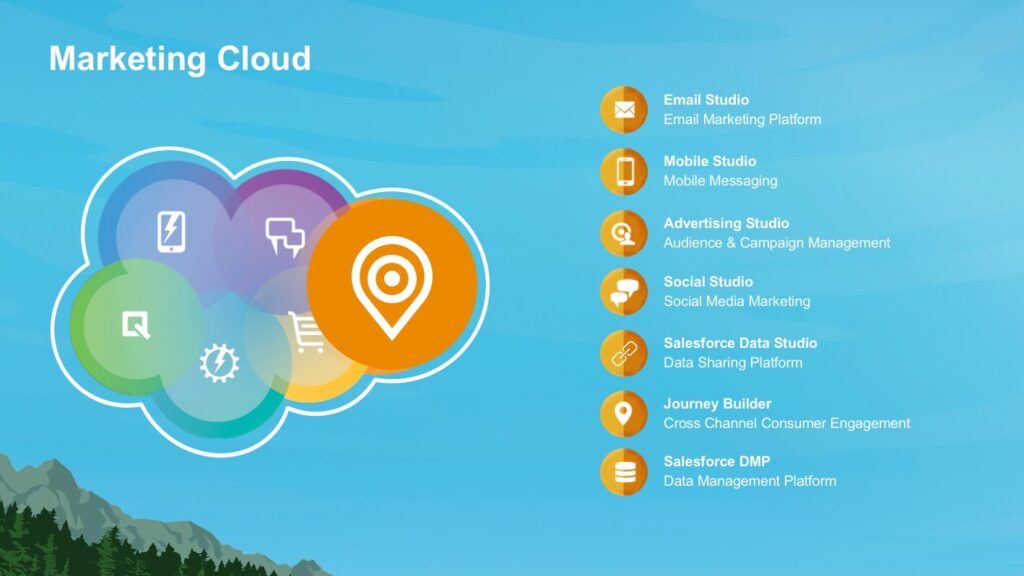
2.1.4 Content Builder: For Managing and Organizing Content
Content Builder is a centralized repository for all your marketing content. Here’s how it streamlines content management:
- Content Creation: Create and store various types of content, including emails, images, videos, and landing pages.
- Version Control: Keep track of different versions of your content and revert to previous versions if needed.
- Personalization: Use dynamic content blocks to personalize content based on customer data.
- Content Reuse: Reuse content across multiple campaigns to save time and maintain consistency.
- Collaboration: Collaborate with team members on content creation and approval workflows.
2.1.5 Analytics Builder: For Tracking and Analysing Marketing Performance
Analytics Builder provides insights into the performance of your marketing campaigns. Here’s how it helps you make data-driven decisions:
- Real-Time Reporting: Monitor key metrics in real-time to track the performance of your campaigns.
- Custom Reports: Create custom reports to analyze specific aspects of your marketing efforts.
- Predictive Analytics: Use Einstein AI to predict future trends and optimize your campaigns.
- Cross-Channel Insights: Gain a holistic view of customer interactions across multiple channels.
- Integration with Salesforce CRM: Sync your analytics with Salesforce CRM to get a comprehensive view of customer engagement.
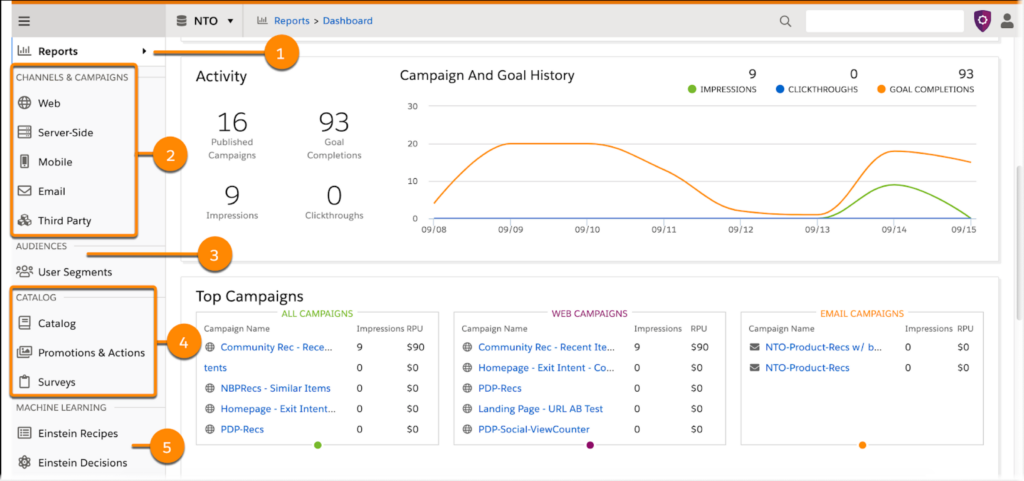
2.2 Integration With CRM Systems
Salesforce Marketing Cloud integrates seamlessly with Salesforce CRM, allowing for a unified system for managing customer relationships. Here’s how this integration enhances your marketing efforts:
- Unified Customer View: Combine data from Marketing Cloud and Salesforce CRM to get a comprehensive view of your customers.
- Automated Data Sync: Ensure that customer data is automatically synced between the two systems, keeping your data up-to-date.
- Lead Management: Use Salesforce CRM to manage leads and opportunities, while Marketing Cloud handles engagement and nurturing.
- Sales and Marketing Alignment: Align sales and marketing efforts by sharing insights and data between the two teams.
- Enhanced Personalization: Leverage data from Salesforce CRM to create highly personalized marketing campaigns.
- Closed-Loop Reporting: Track the impact of marketing campaigns on sales outcomes, enabling better ROI analysis.
3. Email Marketing Capabilities
Email marketing is a crucial component of Salesforce Marketing Cloud. Here’s how you can leverage it:
3.1 Building Email Campaigns With Email Studio
Creating Email Templates
Salesforce Marketing Cloud’s Email Studio provides a robust set of tools for creating and managing email campaigns. One of the key features is the Content Builder, which allows you to create reusable email templates. These templates can be customized to fit various types of campaigns, ensuring consistency and efficiency in your email marketing efforts.
- Drag-and-Drop Builder: The drag-and-drop interface in Content Builder makes it easy to design visually appealing emails without needing extensive coding knowledge. You can add text, images, and other elements to create a professional look.
- Personalized Email Strategies: Use dynamic content to personalize emails based on customer data. This can include personalized greetings, product recommendations, and tailored content based on user behavior.
Example: Welcome Email Series
A welcome email series is an excellent way to introduce new subscribers to your brand. For example, a subscription-based delivery service might send a series of emails that go beyond a simple confirmation message. These emails can include personalized content, such as addressing the customer by name and providing information about upcoming deliveries.
3.2 Email Marketing Analytics
Tracking Open Rates
Monitoring open rates is crucial for understanding how many recipients are engaging with your emails. Open rates are recorded when images render in an email (based on a transparent pixel). Unique open rates track only the first open from each unique recipient.
- Unique Open Rate: Calculated as (unique email opens divided by emails delivered) x 100. This metric helps you gauge the initial engagement of your emails.
- Improving Open Rates: Test subject lines and preheaders to improve open rates. Personalized subject lines and compelling preheaders can significantly increase the likelihood of recipients opening your emails.
Click-Through Rates
Click-through rates (CTR) measure how many recipients click on links within your emails. This metric is essential for understanding the effectiveness of your email content and calls-to-action.
- Unique Click Rate: Calculated as (unique clicks divided by emails delivered) x 100. This metric provides a better gauge of overall audience engagement.
- Click-Through Rate (CTR): Calculated as (all emails clicked divided by emails delivered) x 100. This metric is helpful for tracking specific calls-to-action within your emails.
- Click to Open Rate (CTOR): Calculated as (unique clicks divided by unique opens) x 100. This metric is one of the most accurate for measuring an email’s effectiveness because it considers engagement among recipients who opened the email.
Example: Promotional Campaigns
Promotional campaigns are focused on highlighting specific products, services, or special offers. For example, a fashion retailer might send a series of emails with exclusive discounts on the latest summer fashion trends. By tracking open rates and click-through rates, the marketing team can gauge the effectiveness of their promotional content and adjust future campaigns accordingly.
3.3 Best Practices for Email Marketing
A/B Testing
A/B testing is a powerful tool for improving email campaigns. By testing different elements such as subject lines, visuals, and calls-to-action, you can determine what resonates best with your audience.
- Subject Line Testing: Test different subject lines to see which ones result in higher open rates.
- Content Testing: Experiment with different types of content to see what drives more clicks and engagement.
- Call-to-Action Testing: Test different calls-to-action to see which ones encourage more clicks and conversions.
Segmentation
Segmenting your email list allows you to send more targeted and relevant emails to different groups of subscribers. This can significantly improve open rates and engagement.
- Behavioural Segmentation: Segment your audience based on their behavior, such as past purchases or website interactions.
- Demographic Segmentation: Segment your audience based on demographic data, such as age, location, or gender.
Automation
Automating your email campaigns can save time and ensure consistent delivery. For example, you can automate welcome emails for new subscribers or abandoned cart reminders for users who left items in their shopping carts.
- Welcome Emails: Automate the process of sending welcome emails to new subscribers, ensuring they receive a timely and personalized introduction to your brand.
- Abandoned Cart Campaigns: Send automated reminders to users who left items in their shopping carts, encouraging them to complete their purchases.
4. Data Management and Segmentation
Effective data management and segmentation are key to delivering personalized experiences.
4.1 Data Collection and Integration
To create a comprehensive view of your customers, you need to collect and integrate data from various sources.
Data Studio
Data Studio is a powerful tool for bringing in data from multiple sources. It allows you to create a unified view of your customer data by integrating data from Salesforce CRM, e-commerce platforms, and other third-party applications.
APIs and Connectors
Ensure seamless integration with existing systems using APIs and connectors. Sync customer data from Salesforce Sales and Service Clouds, and connect e-commerce platforms to track purchase behavior. This ensures all tools work together to provide a unified view of your customers.
4.2 Creating Customer Segments
Segmentation allows you to divide your audience into meaningful groups based on behavior, preferences, or demographics. Salesforce Marketing Cloud offers several tools to help you create and manage customer segments.
Waterfall Segmentation
Waterfall Segmentation is a tool that allows you to create segments based on customer behaviour. It provides a visual interface to define and manage segments using a drag-and-drop interface. This method is useful for creating targeted lists based on specific criteria, such as demographics or purchase history.
Contact Builder
Contact Builder is a powerful tool for managing your data extensions and relational data models. It allows you to create complex audience segments based on a combination of demographic, behavioural, and transactional data. With Contact Builder, you can define relationships between data extensions and create a comprehensive view of your customers.
4.3 Best Practices for Segmentation
To ensure your segmentation efforts are effective and efficient, follow these best practices:
Maintain Clean Data
Regularly update and clean your data to ensure accuracy and relevance. Remove bounced or inactive email addresses, and update contact information for accuracy. This not only bolsters campaign performance but also protects your brand reputation.
Create Master Segments
Use master data extensions for more efficient segmentation. Master segments allow you to create reusable segments that can be applied across multiple campaigns. This reduces the need for redundant data processing and ensures consistency in your segmentation efforts.
Use SQL Queries for Complex Segmentation
For more complex segmentation needs, use SQL queries. SQL queries provide advanced capabilities to create highly specific audience segments. You can write SQL queries to extract data from multiple data extensions, combine datasets, and apply complex logic to segment audiences. For example, you can create a segment of customers who have made a purchase in the last 30 days or combine data from several tables to create a detailed customer profile.
Leverage Salesforce Data Cloud
Salesforce Data Cloud is a Customer Data Platform (CDP) that offers advanced data integration capabilities. It allows you to ingest and unify data from various sources for more comprehensive segmentation. Integrating Data Cloud with Marketing Cloud enhances the ability to create detailed and accurate audience segments.
Example Scenario
Let’s consider a scenario where you want to target and send emails to customers who last purchased in the last six months. You can use SQL activity to segment data based on the last purchase date. Here’s how you can do it:
- Transfer Order Data: SFCC users transfer the order data CSV on SFTP.
- Import Data: Marketers import the order data from SFTP into SFMC using the file drop source option and import activity in Automation Studio to capture customer data in SFMC.
- Create SQL Query: Click on Journey Builder → Automation Studio → Create Activity, and select SQL query. Write a SQL query to filter customers based on the last purchase date.
Data Management and Segmentation
Effective data management and segmentation are key to delivering personalized experiences. Salesforce Marketing Cloud offers robust tools to manage and segment your data efficiently.
Data Collection and Integration
Salesforce Marketing Cloud integrates seamlessly with various data sources, allowing you to bring in data from multiple channels.
- Data Studio: Use Data Studio to bring in data from multiple sources, ensuring a unified view of your customer data.
- APIs and Connectors: Ensure seamless integration with existing systems using APIs and connectors provided by Salesforce.
Creating Customer Segments
Segmentation allows you to create targeted audience groups based on specific criteria.
- SQL Queries: Use SQL queries for advanced segmentation. SQL queries provide high precision and flexibility, allowing you to create highly specific audience segments. For example, you can write a SQL query to retrieve all contacts who have made a purchase in the last 30 days.sqlCopy
SELECT SubscriberKey, EmailAddress FROM PurchaseData WHERE PurchaseDate >= DATEADD(day, -30, GETDATE()) - Data Filters: For a non-technical approach, use Data Filters. Data Filters provide a visual interface to segment your customer data using drag-and-drop features. For example, you can create a filter to target customers based on gender.https://deselect.com/blog/segmentation-in-salesforce-marketing-cloud-sfmc/
- Audience Builder: Use Audience Builder to define and manage audiences using a drag-and-drop interface. This tool is user-friendly and provides visual insights into audience composition.
Best Practices for Segmentation
- Maintain Clean Data: Regularly update and clean your data to ensure accurate segmentation.
- Create Master Segments: Use master data extensions for more efficient segmentation.
Segmentation Solutions in Salesforce Marketing Cloud
- SQL Queries: High precision and flexibility, but requires SQL knowledge.
- Audience Builder (Legacy): User-friendly drag-and-drop interface, but considered a legacy tool.
- Journey Builder and Segmentation: Enables real-time personalization and enhances customer journey experiences.
- Salesforce Data Cloud: Comprehensive data integration for more accurate segmentation.
- DESelect Segment: A powerful, intuitive, no-code alternative for creating precise audience segments without requiring SQL knowledge.
Example of Segmentation Using SQL Queries
Suppose you want to target customers who have made a purchase in the last six months. You can use the following SQL query:sqlCopy
SELECT SubscriberKey, EmailAddress
FROM PurchaseData
WHERE PurchaseDate >= DATEADD(month, -6, GETDATE())Example of Segmentation Using Data Filters
To target customers based on gender, you can create a data filter in Email Studio:
- Click on the Create button.
- Choose either Profile Attributes or Data Extensions.
- Apply filters using drag-and-drop features to move fields.
Segmentation Flowchart
Here’s a flowchart illustrating the segmentation process in Salesforce Marketing Cloud:
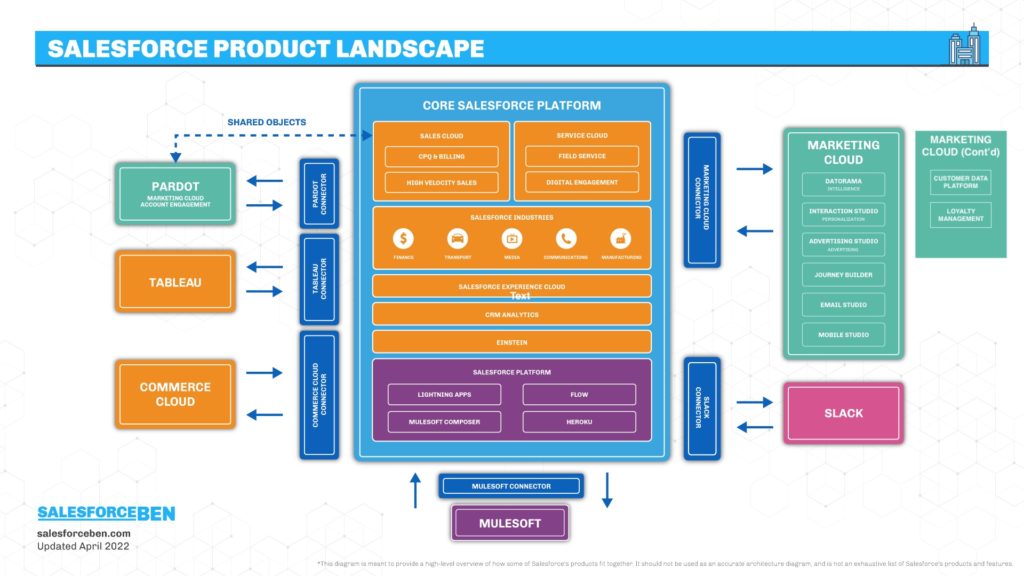
Segmentation Metrics
Track the performance of your segmentation strategies using key metrics:
- Unique Open Rate: (Unique email opens divided by emails delivered) x 100.
- Unique Click Rate: (Unique clicks divided by emails delivered) x 100.
- Click-Through Rate (CTR): (All emails clicked divided by emails delivered) x 100.
- Click to Open Rate (CTOR): (Unique clicks divided by unique opens) x 100.
Segmentation Infographic
Here’s an infographic summarizing key concepts like segmentation and lead scoring:
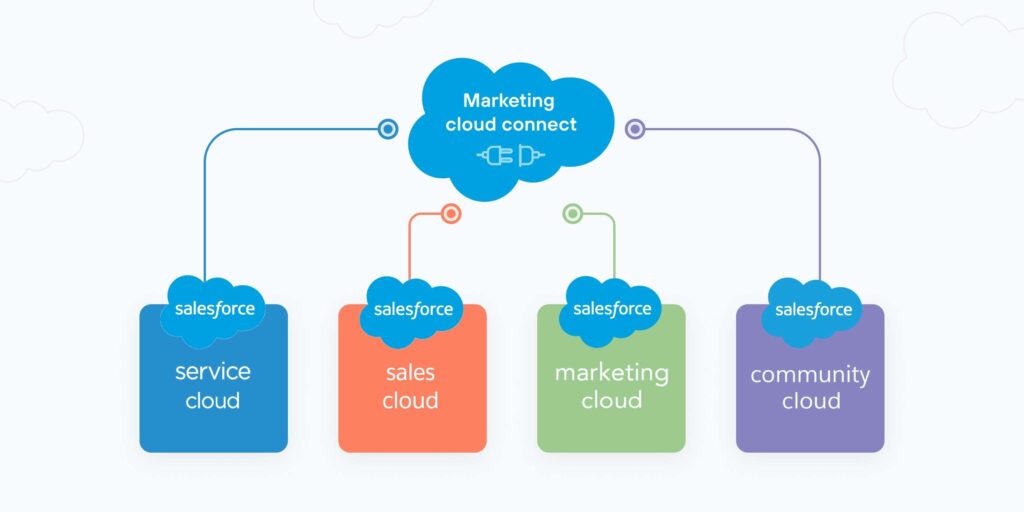
User Feedback on Segmentation
Salesforce Marketing Cloud users often report high satisfaction with its segmentation capabilities, citing ease of use and effectiveness in targeting specific audience groups.
By leveraging these tools and best practices, you can create highly targeted and personalized marketing campaigns that resonate with your audience.
5. Customer Journey Management
Customer journeys are sequences of interactions that guide customers through various stages.
5.1 Designing Customer Journeys
Journey Builder: Journey Builder is a dynamic and flexible tool that allows marketers to design and automate customer journeys. It provides a visual interface where users can map out the various touchpoints and interactions a customer has with a brand. These touchpoints can include email, SMS, advertisements, a brand’s mobile app, popular messaging platforms such as WhatsApp, and more, enabling businesses to create comprehensive and cohesive marketing campaigns.
Core Concepts and Features:
- Drag-and-Drop Interface: Journey Builder’s user-friendly interface makes it easy to map out customer paths. Users can drag and drop activities to create journey paths, set up wait times between steps, and create decision splits based on customer behavior.
- Integration with Salesforce Marketing Cloud: Journey Builder integrates seamlessly with other Salesforce tools, allowing marketers to use customer data to personalize journeys. It connects with Sales Cloud, Service Cloud, and Commerce Cloud, ensuring a unified customer experience.
Mapping the Customer Life Cycle: The customer life cycle shows key stages in a customer’s relationship with a company. Journey Builder lets marketers plan touchpoints for each stage. These might include:
- Welcome emails for new customers
- Birthday offers for loyal shoppers
- Win-back campaigns for inactive users
Utilizing Activities in Journeys: Activities are building blocks for customer journeys. They represent actions taken by the company or customer. Common activities include:
- Sending emails or texts
- Updating customer records
- Triggering internal tasks
Segmentation and Filter Criteria: Segmentation divides customers into groups with shared traits. Filter criteria help target the right people at the right time. Journey Builder offers tools to:
- Split audiences by demographics or behaviour
- Create exclusion lists
- Set entry criteria for journeys
Setting Up API Events: API events trigger actions in Journey Builder when specific customer behaviours occur. To set up an API event, create a new event in Journey Builder and select the API event type. Define the event key, which is a unique identifier. Add data extension fields to capture relevant customer information. Test the API event using Postman or a similar tool before going live.
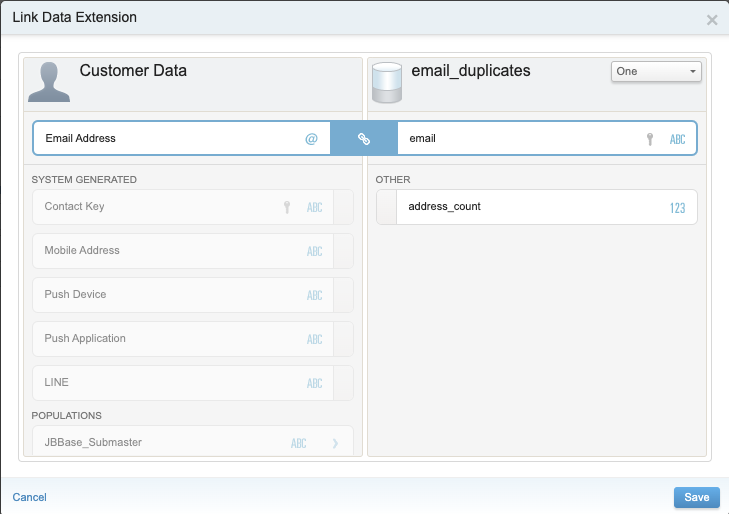
Custom Activities and Actions: Custom activities extend Journey Builder’s capabilities. Create custom activities using Salesforce’s Activity SDK. This lets you add unique steps to journeys. For example, you could build an activity that updates a customer’s loyalty points. Custom activities can also integrate with external systems.
5.2 Optimizing the Customer Journey
Real-Time Engagement: Use real-time data to adjust customer journeys dynamically. Journey Builder can trigger actions based on customer behaviours as they happen, ensuring that interactions are timely and relevant.
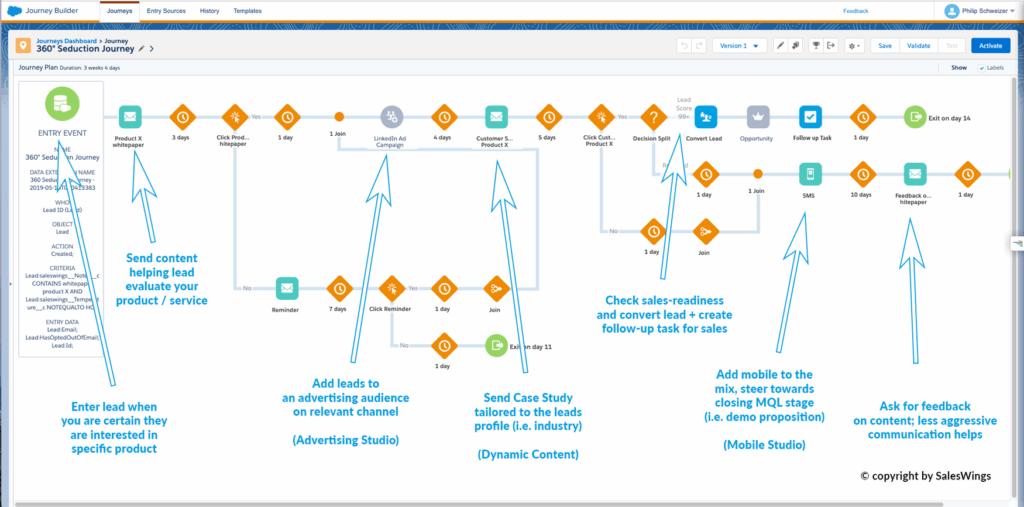
Testing and Iteration: Continuously test and refine your journeys for better performance. Journey Builder offers tools to track key performance indicators, such as open rates, click-through rates, and conversion rates for emails and other touchpoints.
Monitoring and Analysing Performance: Journey Builder provides built-in analytics tools to track customer interactions. You can view metrics like email open rates, click-through rates, and conversion rates directly on the platform. Use the journey map to see how customers move through different paths. This visual representation helps identify successful touchpoints and areas for improvement.
A/B Testing: A/B testing allows marketers to compare different journey versions to see which performs better. This can involve testing different content, timing, or paths within the journey.
Optimizing for Customer Satisfaction: Customer satisfaction is a crucial measure of journey effectiveness. Journey Builder integrates with Salesforce’s customer feedback tools, allowing marketers to collect and analyse customer responses at various points in the journey. Net Promoter Score (NPS) surveys can be sent after key interactions to gauge how likely customers are to recommend the brand. Customer satisfaction (CSAT) scores can also be tracked for specific touchpoints.
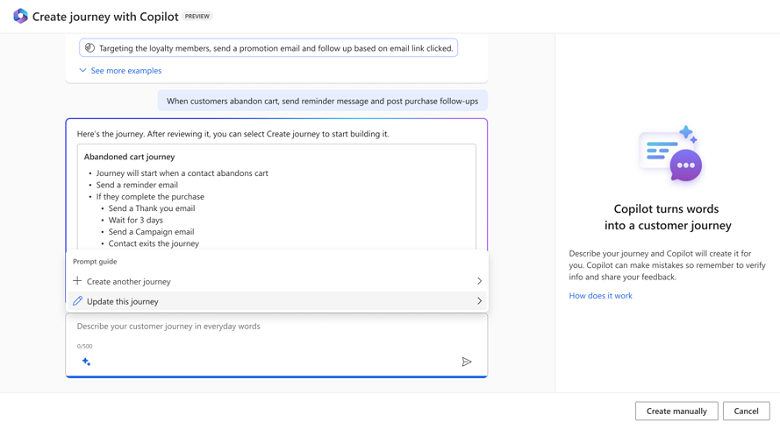
Scalability and Best Practices: Journey Builder can handle growing customer bases and complex campaigns. It offers tools to manage large-scale marketing efforts while keeping best practices in mind. Using Journey Builder well means following some key rules, such as keeping customer data clean and up-to-date, testing journeys before launching them to large groups, and making journeys personal by using customer data to tailor messages.
By leveraging these features and best practices, you can create personalized, dynamic customer journeys that enhance engagement and drive growth. Journey Builder’s flexibility and integration capabilities make it a powerful tool for marketers looking to optimize their customer interactions.
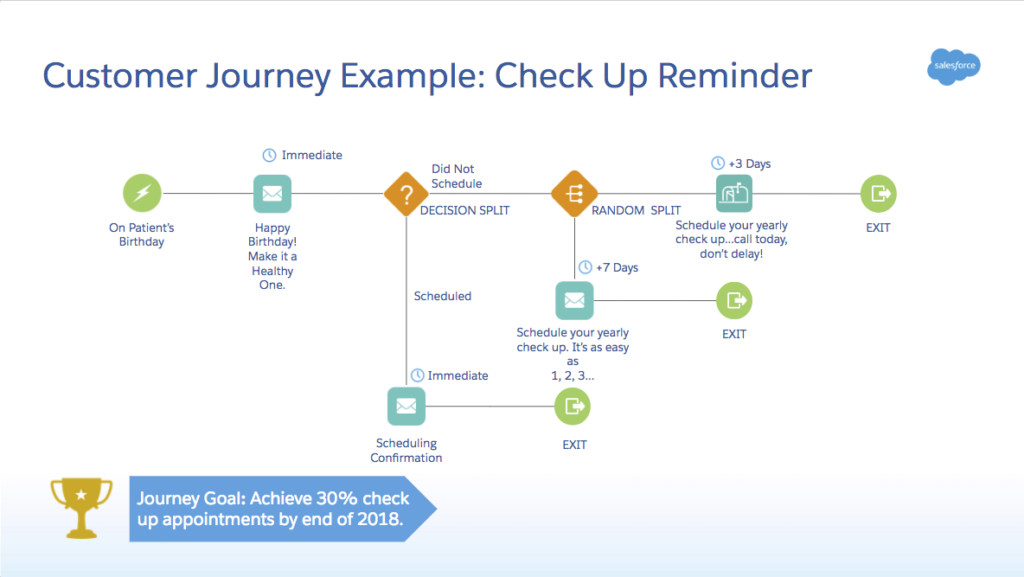
6. Lead Scoring and Grading
6.1 Lead Scoring
Automated Scoring
Lead scoring is a method used by sales teams to rank potential customers by assigning values based on their behaviour, demographics, and engagement with your business. This process measures the quality of leads brought into the sales funnel and determines the likelihood of converting a sales lead into a customer.
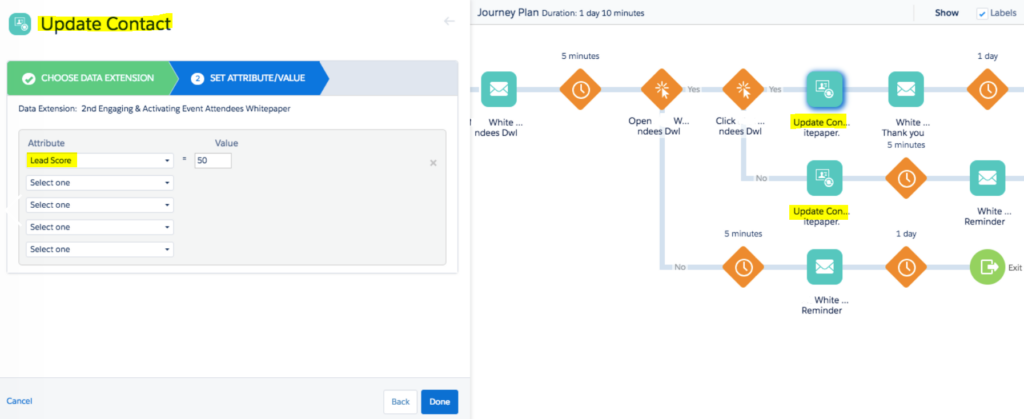
Key Components of an Effective Lead Scoring System
- Demographic Data: Information that describes your lead, such as job title, location, budget, or role in the sales decision-making process.
- Company Data: Information that describes your lead’s company, such as industry, size, or type.
- Behavioural Data: Based on actions a lead takes when interacting with your company, such as downloading a report or attending a conference. This includes email engagement (open and click-through rates) and social media engagement (click-throughs, comments, and shares).
- Spam Data: Data from spam, junk, or fake information input on your landing page forms. This lead data type should be filtered out or given a negative lead score.
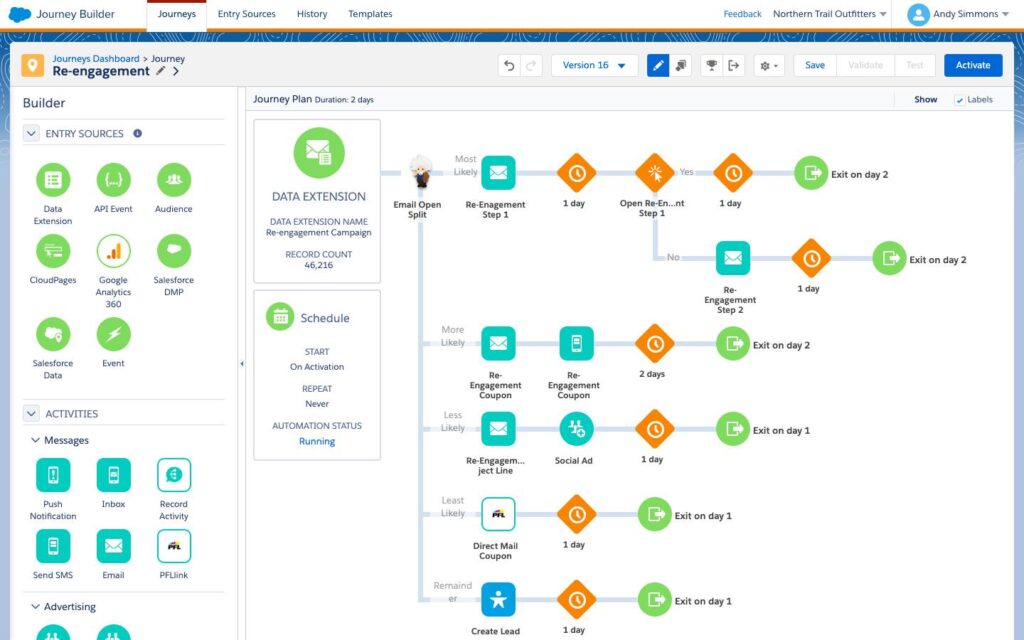
Implicit vs. Explicit Scoring
- Implicit Scoring: Based on observed behaviours or inferred information, such as a lead’s visit to the sales page on your website or inferred location based on their email address.
- Explicit Scoring: Based on direct information you’ve received from the lead, such as company size, job title, or location.
Steps to Implement Lead Scoring
- Calculate the Conversion Rate for All Leads: Use the formula:(Number of leads converted to customers)/(Total number of leads generated)×100This gives you a baseline conversion rate.
- Define Your Ideal Customer: Choose attributes based on your current customers’ demographics and behaviour data. Consult with your sales and marketing teams to identify common characteristics of successful conversions.
- Calculate the Close Rates for Each Attribute: Determine how many of your qualified leads become customers based on their demographics or behavior attributes. Use your CRM’s predictive lead scoring to automate this process.
- Compare Close Rates with the Baseline Conversion Rate: Assign points to attributes with higher close rates. For example, if leads who watch a company webinar have a 75% close rate compared to a baseline of 50%, they might receive 25 points.
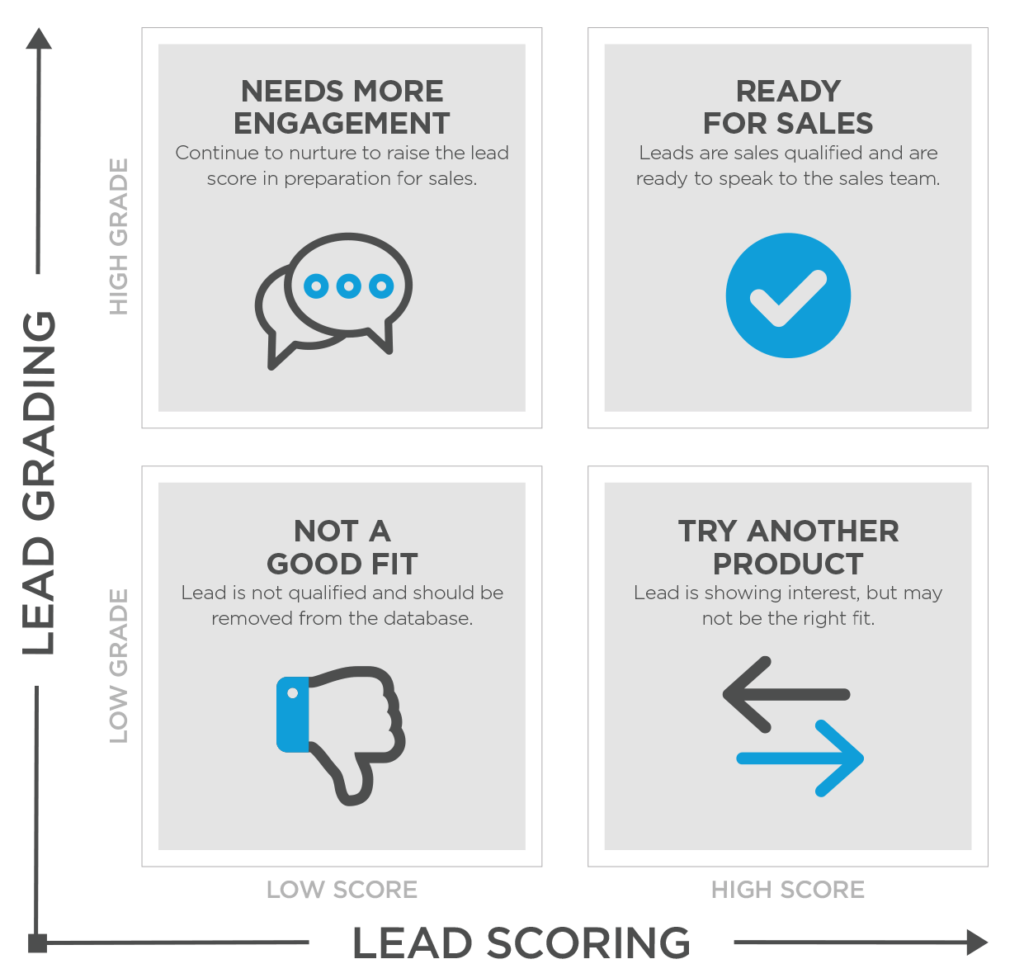
Examples of Successful Lead Scoring
- AI-Based Lead Scoring: A software company implemented an AI-based predictive lead scoring tool and saw a 27% increase in sales. The sales team could focus more on high-scoring leads, leading to higher conversion rates.
6.2 Lead Grading
Automated Grading
Lead grading evaluates leads based on demographic and firmographic data to determine their fit with your ideal customer profile. This helps in qualifying leads beyond just their engagement behaviours.
Best Practices for Lead Scoring and Grading
- Align Models with Business Goals: Ensure your scoring and grading models align with your business objectives. Regularly review and adjust your models based on performance data.
- Integrate with CRM: Sync your lead scoring and grading models with your CRM system to ensure data accuracy and consistency.
- Use Predictive Analytics: Leverage Salesforce Einstein’s predictive analytics to refine your scoring models. Einstein can analyse historical data to predict which leads are most likely to convert.
- Regularly Update Data: Maintain data hygiene by regularly updating and cleaning your data. Remove inactive or bounced email addresses to improve the accuracy of your scoring models
7. Personalization and AI
Personalization is key to engaging customers effectively.
7.1 Einstein AI and Personalization
AI-Powered Insights: Salesforce Marketing Cloud leverages Einstein AI to analyse customer data and predict needs. Einstein AI uses machine learning to identify patterns and trends in customer behaviour, preferences, and historical interactions. This allows you to create highly personalized experiences that resonate with individual customers. For example, Einstein AI can predict which products a customer is likely to purchase next, enabling you to send targeted offers and recommendations.
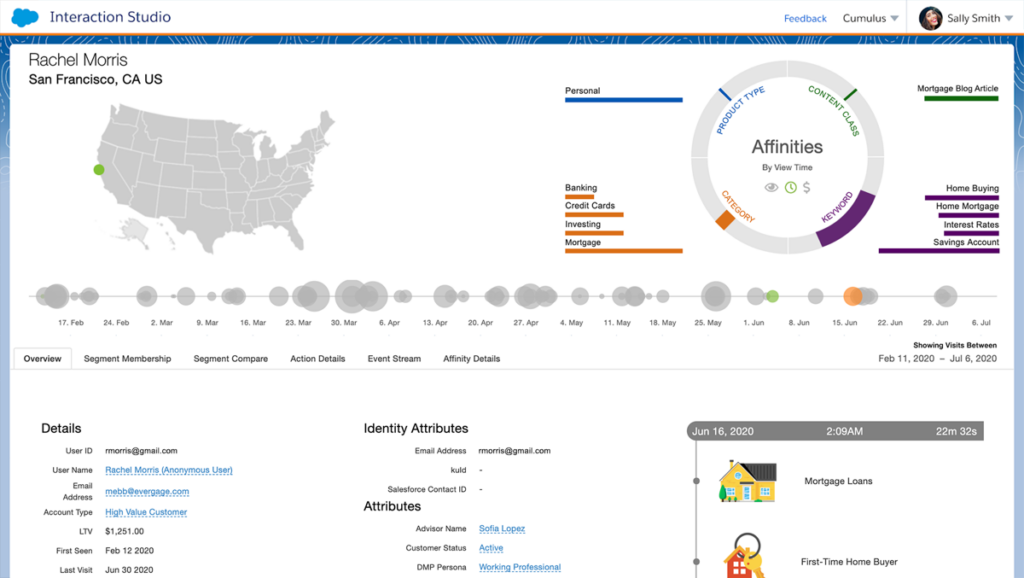
A/B Testing: Refine your strategies using A/B testing and comprehensive reporting. Salesforce Marketing Cloud provides robust A/B testing capabilities that allow you to experiment with different elements of your campaigns, such as subject lines, images, and call-to-action buttons. By analysing the performance of these variations, you can determine what resonates most with your audience and optimize your campaigns for better results.
7.2 Real-Time Engagement
Dynamic Content: Tailor content dynamically based on real-time customer data. Salesforce Marketing Cloud’s dynamic content feature allows you to personalize emails and other marketing messages in real-time. This means that the content can change based on the recipient’s behaviour, preferences, and context at the moment of delivery. For example, you can use dynamic content to show personalized product recommendations, special offers, or even change the language of the email based on the customer’s location.
Unified Experience: Ensure a cohesive experience across all channels. Salesforce Marketing Cloud enables you to deliver consistent and personalized experiences across multiple channels, including email, social media, SMS, and mobile apps. By integrating data from all these channels, you can create a unified customer journey that feels seamless and relevant at every touchpoint. For example, a customer who browses a product on your website can receive a personalized email with more information about that product, followed by a targeted social media ad and an SMS reminder.
Real-Time Customer Data: Use real-time customer data to enhance personalization. Salesforce Marketing Cloud’s Einstein Decisions feature uses real-time and historical data to identify the most relevant offers and content for each customer. This ensures that every interaction is timely and relevant, increasing the likelihood of engagement and conversion.
Einstein Engagement Frequency: Optimize the timing of your communications with Einstein Engagement Frequency. This AI-driven feature analyses customer engagement patterns to determine the best times to send emails and other messages. By sending communications when customers are most likely to engage, you can improve open rates and click-through rates.
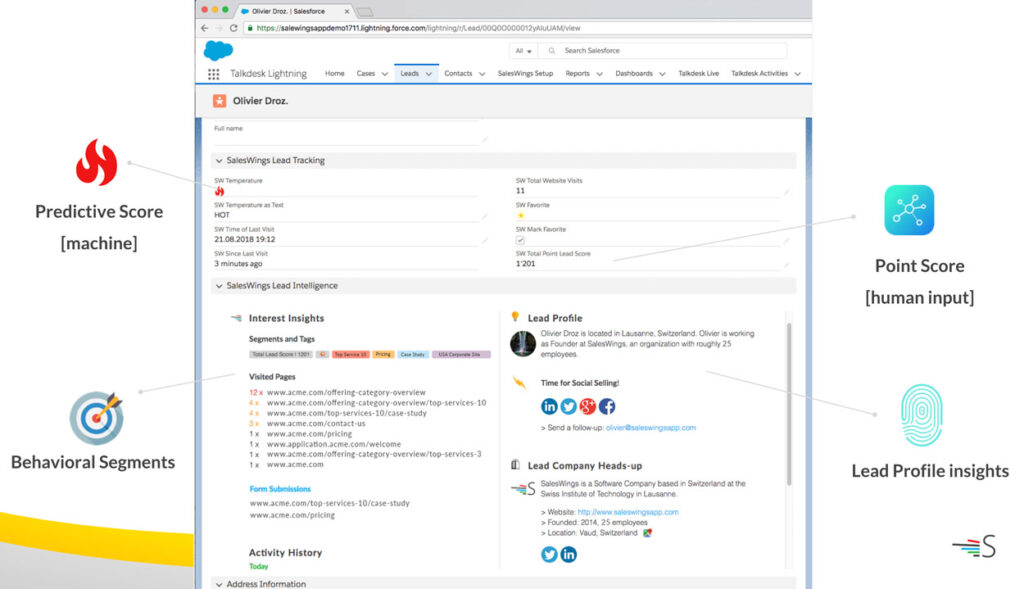
Einstein Send Time Optimization: Ensure that your emails are sent at the optimal time for each recipient. Einstein Send Time Optimization uses AI to analyse customer behaviour and determine the best time to send emails, maximizing the chances of engagement.
By leveraging Einstein AI and real-time engagement features in Salesforce Marketing Cloud, you can create highly personalized and effective marketing campaigns that drive engagement and conversion.
8. Cross-Channel Marketing Execution
Engage customers across multiple channels.
8.1 Connecting With Mobile Users
Engaging mobile users is essential in cross-channel marketing. With Salesforce’s Mobile Studio, businesses can send targeted messages straight to users’ devices, including SMS, push notifications, and group messaging.
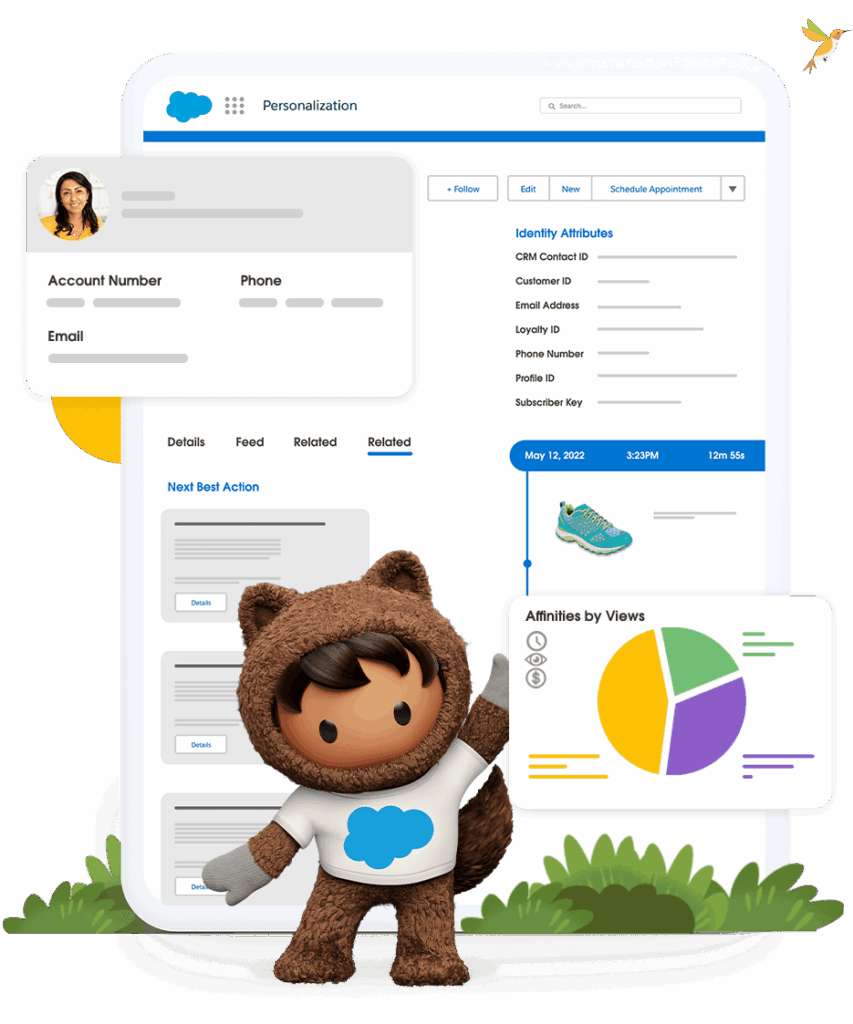
SMS and MMS
- MobileConnect: Use MobileConnect to send SMS and MMS messages. This tool allows you to create customized messages based on customer behaviours and preferences, helping brands communicate time-sensitive offers or updates effectively.
- Personalization: Tailor messages to individual preferences, such as location-based targeting or behaviour-driven messaging. This enhances relevance, making customers more likely to engage with mobile content.
Push Notifications
- Engagement: Engage users with push notifications. These quick, concise messages drive real-time engagement and can be customized based on user behaviour.
- In-App Messaging: Go beyond simple notifications with in-app messaging. This interactive layer within apps helps brands deliver targeted messages while customers are actively engaged, increasing the likelihood of conversion.
8.2 Engaging on Social Media
Social media platforms offer a direct line to consumers. Salesforce uses Social Studio to help brands manage and analyse social interactions.
Social Studio
- Listening Tools: Track conversations and brand mentions using listening tools. This allows companies to respond quickly and effectively, enhancing customer relationships.
- Content Sharing: Use visuals, videos, and interactive posts to attract attention. Tailor messages to specific groups by segmenting audiences, ensuring relevance.
Social Ads
- Targeted Campaigns: Run targeted social media ads using Social Studio. By analysing customer data, you can create ads that resonate with specific audience segments.
- Performance Tracking: Monitor the performance of your social media campaigns to refine your approach, focus on successful tactics, and foster community engagement.
8.3 Leveraging Web Experiences
A seamless web experience is crucial for keeping customers engaged. Salesforce’s tools allow businesses to create customized web content.
Landing Pages
- CloudPages: Create and manage landing pages with CloudPages. Integrate data analytics to understand what users seek and tailor web interactions to their interests.
- Personalized Content: Use dynamic content to personalize landing pages based on user behaviour and preferences. This can include personalized product recommendations and special offers.
Web Personalization
- Einstein AI: Use Einstein AI to personalize web experiences. This tool analyses customer interactions and historical data to deliver tailored content that resonates with individual users.
- A/B Testing: Optimize web pages for better interaction by A/B testing different elements. This helps you identify what content resonates most with your audience.
8.4 Coordinated Advertising Efforts
Coordinated advertising across channels amplifies reach and impact. Advertising Studio from Salesforce helps manage campaigns on various platforms, including Google search console, Google ads, Facebook, and more.
Targeted Advertising
- Demographic Targeting: Ensure your ads reach the right audience by targeting specific demographics. Use comprehensive data to fine-tune ads to meet customer preferences.
- Cross-Channel Monitoring: Monitor audience interactions across multiple networks to adjust strategies for better results. Consistent messaging across channels builds brand recognition and trust.
Unified Strategy
- Channel Coordination: Create a unified strategy by coordinating advertising with other channels, like mobile and social. This alignment ensures that consumers receive coherent and engaging messages wherever they encounter the brand.
- Real-Time Adjustments: Implement real-time adjustments to your campaigns based on performance data. This agility ensures that your advertising efforts remain relevant and effective
9. Marketing Analytics and Insights
Tracking and analysing your marketing performance is crucial for understanding the effectiveness of your campaigns and making data-driven decisions. Salesforce Marketing Cloud provides robust tools to help you gain insights into your marketing efforts.
9.1 Tracking Marketing Performance
Effective marketing performance tracking is essential for understanding the impact of your campaigns. Salesforce Marketing Cloud’s Analytics Builder is a powerful tool that helps you create, customize, and analyse reports and dashboards tailored to your needs.
Analytics Builder:
- Standard Reports: These are pre-built reports that allow you to assess your campaign performance without needing technical expertise. You can run these reports manually or set them up to run automatically.
- Data Views: Retrieve engagement data from Marketing Cloud tables through a query activity in Automation Studio.
- Discover Reports: These are tailored reports generated based on specific scenarios, providing valuable insights with simplicity at its core.
Types of Reports:
- Email Studio: Track the performance of your email campaigns.
- Journey Builder: Monitor the effectiveness of your customer journeys.
- MobileConnect and MobilePush: Analyze the engagement from SMS and push notifications.
- CloudPages: Evaluate the performance of your landing pages.
- Contacts: Gain insights into your contact data and engagement.
Getting Started with Reports:
- Reports Overview Screen: This is the central hub for all your reports in Email Studio, Mobile Studio, CloudPages, SocialPages, Microsites, JourneyBuilder, and Contact Counts.
- New Reports: Shows the latest reports added to the Marketing Cloud.
- Reports Shortcut: Create and manage shortcuts for frequently used reports.
- Reports Catalog: A comprehensive list of all available reports.
- Saved Reports Menu: Access saved reports related to specific categories.
- Saved Reports Grid: View all your saved reports with useful details, and use filters and sorting options to find them easily.
- Activity Log Screen: Detailed information on reports, including lists of reports run today, scheduled reports, and the history of previously run reports.
9.2 Marketing Cloud Intelligence
Marketing Cloud Intelligence provides advanced analytics and predictive capabilities to help you make smarter decisions based on data-driven insights.
Predictive Analytics:
- Predictive Intelligence: Use data science to forecast future customer behavior and identify the most effective marketing actions and strategies. For example, Amazon uses predictive analytics to provide personalized product recommendations based on customers’ past purchases and behaviors.
- Einstein Marketing Insights: AI-powered insights analyze marketing campaigns and automatically reveal strategic tweaks to capitalize on what’s working and correct what’s not.
Reporting:
- Data Canvas: A suite of visualization capabilities that combines dashboarding with sophisticated data discovery tools to create compelling, data-driven stories and analyses.
- SmartLenses: AI-powered one-click dashboards that automatically set up KPIs and data modeling from key channels, providing instant insights into important metrics and trends.
- Custom Analytics: Deploy your own predictive or prescriptive models across all your marketing data with deep analytical and developer tools, including support for R and Python.
Activation and Collaboration:
- Activate: Conduct cross-platform actions and notifications using Action Rules and the Activation Connector Library to manage campaigns on platforms like Facebook, Google Ads, and Twitter directly from Intelligence.
- Collaborate: Enhance team collaboration by sharing data and insights from the widget to dashboard level via live embeddable links, downloadable reports, or any image file type. Integrate with Slack or any chat app to broadcast data to all teams
10. Advanced Features and Extensions
Salesforce Marketing Cloud offers a suite of advanced features and extensions that can significantly enhance your marketing efforts. These features are designed to provide deeper personalization, more sophisticated campaign management, and enhanced data analytics. Below, we will explore two key areas: Marketing Cloud Personalization and Distributed Marketing Solutions.
10.1 Marketing Cloud Personalization
Personalized Recommendations
Marketing Cloud Personalization leverages AI and machine learning to provide highly personalized product recommendations. This feature helps you understand customer behavior and preferences, allowing you to deliver relevant content and offers.
- Einstein Personalization: Use Einstein AI to predict customer behavior and personalize their experience. Einstein Engagement Scoring helps you predict engagement and segment your audience more effectively.
- Dynamic Content Creation: Build dynamic content directly within the Content Builder using the Data Cloud data graph. This allows you to configure rules that operate against your data graph, ensuring your marketing material is responsive to your audience.
Content Optimization
Optimize your content delivery based on customer behavior to ensure maximum engagement.
- Real-Time Personalization: Dynamic content delivery adjusts in real-time based on user behavior, preferences, or context. This ensures personalized interactions across all touchpoints.
- A/B Testing: Run A/B tests to determine the most effective content and messaging. Marketing Cloud Advanced Edition allows you to test up to ten paths with varied channels, messaging copy, and cadence.
Example Scenario
Imagine you run an e-commerce business. A customer visits your website and browses products but doesn’t make a purchase. Using Marketing Cloud Personalization, you can send them an email with personalized product recommendations based on their browsing history. This not only enhances the customer experience but also increases the likelihood of conversion.
10.2 Distributed Marketing Solutions
Localized Campaigns
Run localized marketing campaigns with Distributed Marketing to cater to different regions and audiences.
- Multi-Brand Management: Manage multiple brands under a single umbrella, allowing for streamlined campaign management and segmentation across different brand audiences.
- Localized Content: Create and manage localized content to ensure relevance and engagement in different regions.
Corporate Branding
Ensure consistent branding across all marketing efforts to maintain a cohesive brand image.
- Brand Consistency: Use templates and predefined content blocks to maintain consistent branding across all channels.
- Centralized Management: Manage branding elements centrally and distribute them across different campaigns and channels.
Example Scenario
Suppose you manage marketing for a global company with multiple regional offices. Using Distributed Marketing Solutions, you can create a centralized campaign template and allow regional teams to customize it for their specific needs while maintaining overall brand consistency. This ensures that each region can run localized campaigns without compromising the global brand image.
Graphics and Charts
To better illustrate these concepts, consider including the following graphics and charts:
- Flowchart of Personalized Recommendations:
- Step 1: Customer visits website and browses products.
- Step 2: Marketing Cloud captures browsing data.
- Step 3: Einstein AI analyzes data and generates personalized recommendations.
- Step 4: Personalized email is sent to the customer with product recommendations.
- Chart Showing A/B Testing Results:
- X-axis: Different versions of the campaign (A, B, C, etc.).
- Y-axis: Engagement metrics (open rates, click-through rates).
- Data Points: Visual representation of how different versions perform.
- Diagram of Distributed Marketing Workflow:
- Central Hub: Centralized campaign management.
- Regional Nodes: Localized campaign customization.
- Consistent Branding: Arrows showing consistent branding elements distributed to regional nodes.
11. Best Practices and Tips
Follow these best practices to get the most out of Salesforce Marketing Cloud.
11.1 Data Quality
Regular Updates: Keeping your data up-to-date is crucial for accurate segmentation and effective marketing campaigns. Regularly update contact information to ensure accuracy and relevance. This includes removing bounced or inactive email addresses and updating contact details.
Avoid Over-Segmentation: While segmentation is powerful, over-segmentation can lead to overly complex and unmanageable segments. Keep your segments meaningful and manageable to ensure they are actionable and effective.
11.2 Continuous Improvement
Test and Iterate: Regularly test and refine your strategies to adapt to changing customer preferences and market conditions. Test various elements such as subject lines, email designs, content, send times, and CTAs to see what works best. Use A/B testing to compare different versions of your campaigns and make data-driven decisions based on the results.
Leverage Training Resources: Utilize Salesforce Trailhead and other training resources to stay updated on the latest features and best practices. Continuous learning ensures that you can leverage all the capabilities of Salesforce Marketing Cloud effectively.
Analyze and Act on Insights: Use the Analytics Builder in Salesforce Marketing Cloud to monitor key metrics such as open rates, click-through rates, and conversion rates. Identify underperforming campaigns and make adjustments based on the insights gained. A data-driven approach ensures continuous improvement in your marketing efforts.
Ensure Data Hygiene and Compliance: Maintain data hygiene by regularly cleaning your data and ensuring compliance with data protection laws such as GDPR and CAN-SPAM. This not only improves campaign performance but also protects your brand’s reputation.
Use Dynamic Content and Predictive AI: Enhance personalization by using dynamic content blocks to show different content based on user attributes. Leverage Salesforce Einstein for predictive insights to recommend products or anticipate customer needs. This helps create messaging that feels genuinely tailored and relevant.
Provide a Consistent Omnichannel Experience: Ensure consistent communication across all channels, including email, social media, SMS, and push notifications. Align your messaging and sync your campaigns to avoid conflicting information and provide a seamless customer experience.
11.3 Additional Best Practices
Leverage Automation Studio: Automate repetitive processes using Salesforce Marketing Cloud’s Automation Studio. This can include scheduling email blasts, automating data imports, and setting up drip campaigns to nurture leads. Automation saves time and allows your team to focus on more strategic tasks.
Integrate Data Across Platforms: Integrate data from various sources using APIs and connectors to have a comprehensive view of your customers. Sync customer data from Salesforce Sales and Service Clouds and connect e-commerce platforms to track purchase behavior. Proper data integration ensures smarter marketing decisions.
Secure Your CloudPages: When creating CloudPages, ensure they are secure by using features like IP address whitelisting, Referrer URL, and Login Authentication. Purchase SSL certificates to secure URLs for CloudPages, email tracking links, and other essential components.
Optimize Performance: Use AMPscript efficiently by limiting the number of Lookup functions and merging data into a single sendable data extension before sending. Test with data identical to your live sendable data to ensure optimal performance.
Implement Contact Delete Best Practices: When implementing contact deletion processes, ensure they are final and understand that Marketing Cloud cannot restore deleted contact information. Follow recommended security settings and best practices for contact deletion.
By following these best practices, you can optimize your use of Salesforce Marketing Cloud, improve campaign performance, and deliver a more personalized and engaging customer experience.
12. Conclusion
Salesforce Marketing Cloud offers a robust suite of tools to enhance your marketing efforts. By leveraging its capabilities, you can create personalized customer journeys, manage data effectively, and drive engagement across multiple channels. This guide should serve as a comprehensive resource to help you get started and optimize your use of Salesforce Marketing Cloud.
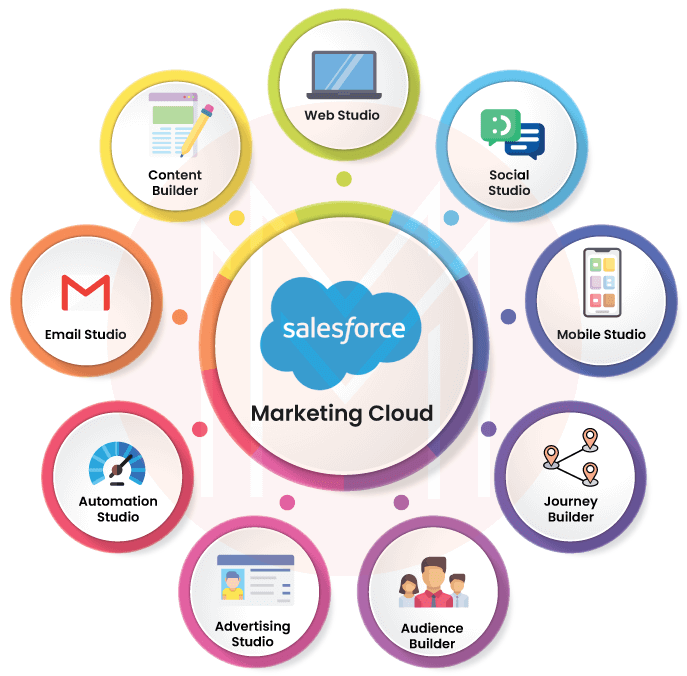
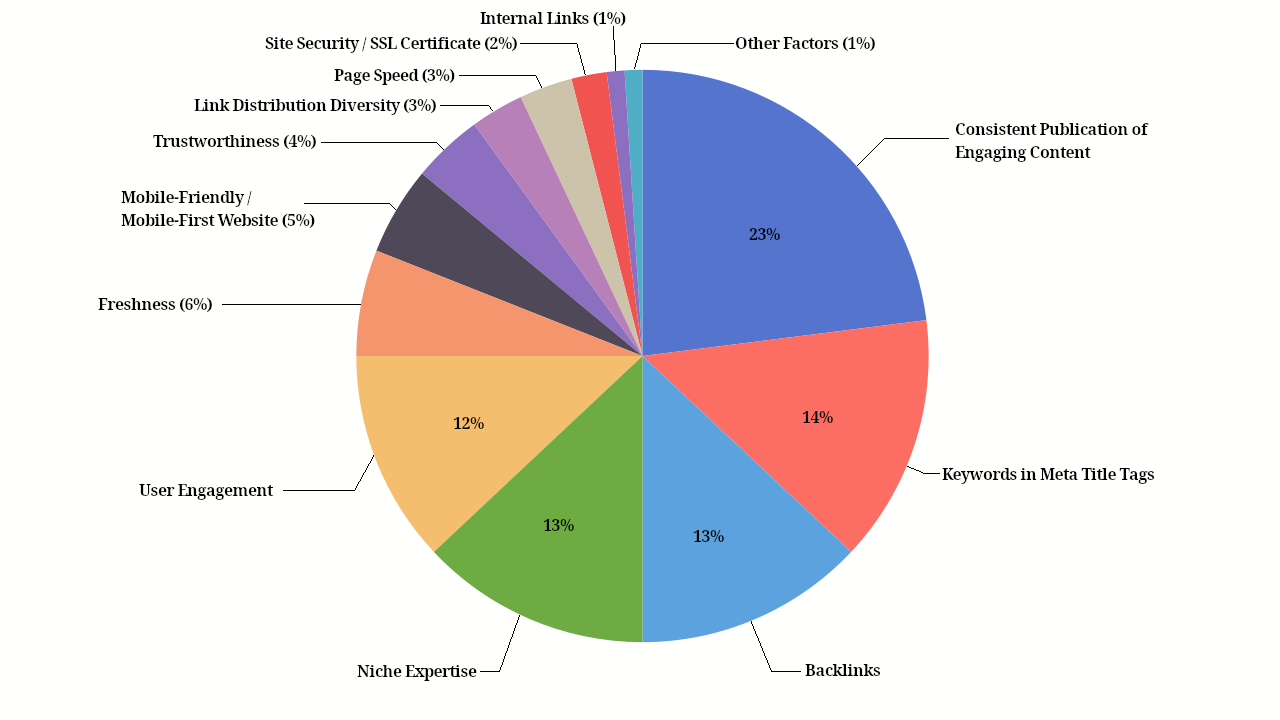
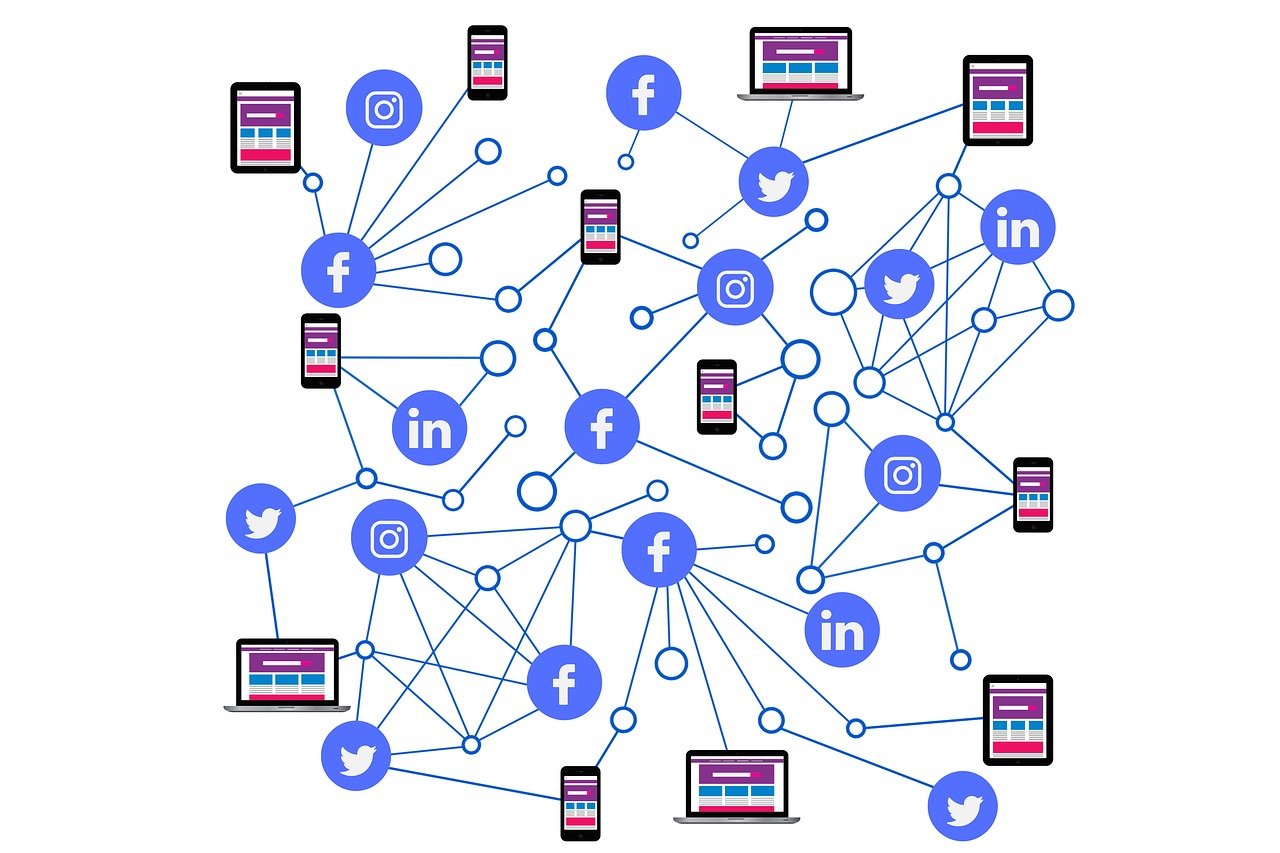
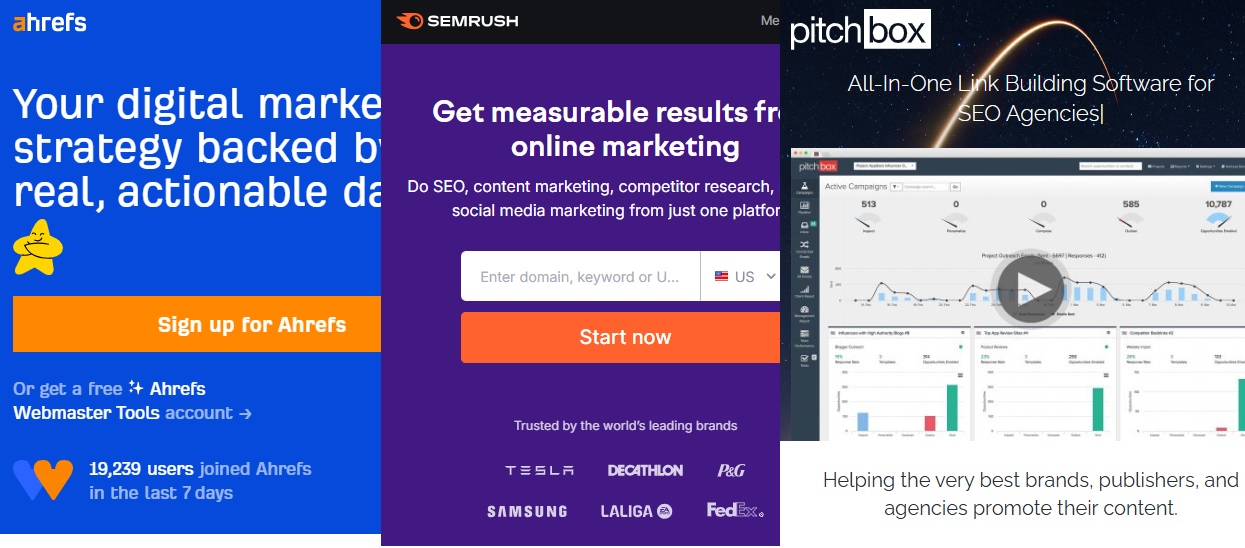
Post Comment